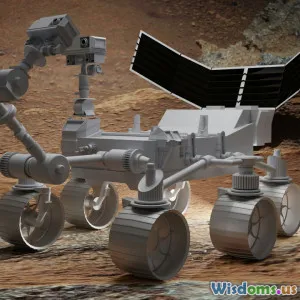
Space Based Weapons: The Next Arms Race
8 min read Explore how space-based weapons are fueling the new global arms race, transforming military strategy and international security dynamics. (0 Reviews)
Space Based Weapons: The Next Arms Race
Introduction
From science fiction to stark reality, the idea of weapons in space once seemed a futuristic fantasy. Today, however, it has steadily morphed into a pressing concern at the heart of global military strategy. Space-based weapons, capable of orbiting Earth or deploying strikes from this vantage point, represent the frontier of a burgeoning arms race among leading military powers. This race is not just about technological prowess but revolves around redefining military dominance, strategic deterrence, and, ultimately, global security.
This article delves into the current landscape of space-based weapons, the motivations behind their development, the specific technologies involved, and the profound implications they have for international relations and future warfare.
The Genesis of the Space Arms Race
Historically, space has been viewed as a domain for peaceful exploration and satellite-based utility. The 1967 Outer Space Treaty established guidelines to prevent the placement of nuclear weapons or weapons of mass destruction in orbit. Yet, advancements in technology and shifting geopolitical dynamics have challenged these limitations.
By the early 21st century, major powers—chiefly the United States, China, and Russia—began investing heavily in capabilities that push the boundaries of military activities in space. An illustrative example is China's 2007 anti-satellite (ASAT) test, where it successfully destroyed one of its weather satellites using a missile. This action, and the ripple effects it caused globally, underscored the reality that space was becoming militarized beyond mere satellite communications or GPS.
Types of Space-Based Weapons
Space-based weapons can take multiple forms, broadly categorized as kinetic, directed-energy, or missile platforms.
Kinetic Kill Vehicles (KKVs)
These are essentially projectile weapons designed to destroy targets by direct impact. An example is the USA's "Exoatmospheric Kill Vehicle" (EKV), a component of the Ground-Based Midcourse Defense system, intended to intercept ICBM warheads in space.
Directed-Energy Weapons (DEWs)
Lasers and particle beams fall under this category, wielding the power of focused energy to damage or disable adversary satellites or incoming missiles. The U.S. Air Force’s development of airborne and spaceborne laser systems aims to provide rapid response against aerial and space threats.
Orbital Missile Platforms
Though more speculative, some military researchers hypothesize weapons platforms stationed in orbit capable of launching missiles or delivering precision strikes on Earth's surface. This concept revives echoes of the Soviet Union’s R-36 Orbital Bombardment System from the Cold War era but with modern sophistication and tactical range.
Drivers Behind the New Space Arms Race
Strategic Supremacy and Deterrence
Control of space equates to a strategic advantage on Earth—for reconnaissance, communication, navigation, and missile warning. Dominance in space can undermine an opponent's military operations and provide an edge in conflict scenarios. Thus, nations aim to assert space superiority as a form of deterrence, preventing hostile actions in this domain.
Anti-Access/Area Denial (A2/AD) Capabilities
Space-based weapons can enhance a country's ability to inhibit rival forces' access to key regions. For example, disabling enemy satellites cripples communications and targeting, offering tactical supremacy in contested areas such as the South China Sea.
Rapid Technological Advancements
Breakthroughs in miniaturization, propulsion, and artificial intelligence have lowered entry barriers, enabling a wider array of weapons systems to operate in space. The launch cost reduction due to private companies (e.g., SpaceX's reusable rockets) accelerates this capability proliferation.
International Responses and Treaty Challenges
The arms race in space brings urgent calls for diplomatic frameworks to mitigate escalation. Unfortunately, existing treaties such as the Outer Space Treaty, the Moon Agreement, and various UN resolutions lack enforcement mechanisms specifically for advanced weaponry.
In 2020, Russia and China proposed a draft Treaty on the Prevention of the Placement of Weapons in Outer Space, aiming to ban weapons deployment in orbit. However, this initiative stalled due to rejection by the United States and its allies, emphasizing divergent interests in maintaining strategic freedom and technological advantage.
Geopolitical Implications
Increased Risk of Conflict
The dual-use nature of many space technologies complicates transparency and trust. A satellite can serve peaceful or hostile purposes, making misinterpretations potential flashpoints for conflict.
As former U.S. Secretary of Defense William Perry has warned, “Once weapons begin flying through space, the risks of a catastrophic war will increase dramatically.”
Threat to Civil and Commercial Satellite Infrastructure
More than half of global communications, navigation, weather forecasting, and financial networks depend on satellites vulnerable to attacks from space-based weapons. Disruption could cripple civilian life and economies on an unprecedented scale.
Shifts in Power Balances
Smaller states and emerging powers may find themselves increasingly dependent on alliances or subject to pressure in the evolving space-military architecture dominated by the established spacefaring nations.
Future Outlook and Strategic Recommendations
The next decades will likely see rapid developments in space-based weapons technology. Governments should weigh aggressive development against the risks of an uncontrolled arms race in orbit.
Strengthening Arms Control
International stakeholders must reinvigorate dialogue and develop enforceable norms and monitoring mechanisms, ideally incorporating transparency measures and confidence-building protocols.
Investment in Space Situational Awareness (SSA)
Robust SSA systems can help track objects and potential threats, reducing the chance of accidental clashes.
Encouraging Multi-Domain Defensive Strategies
Diversifying defense approaches across air, ground, cyber, and space domains will create resilience. Emphasizing non-kinetic and passive defense could mitigate escalation.
Conclusion
Space-based weapons epitomize the convergence of cutting-edge technology and 21st-century strategic imperatives. They promise significant military advantages but also pose existential risks for global security and the peaceful use of outer space.
Navigating this complex arms race demands farsighted diplomacy, robust policy frameworks, and international cooperation to prevent escalation while harnessing space for mutual benefit. The stakes are enormously high—not just the dominance of militaries, but the preservation of space as a sanctuary for mankind’s collective advancement.
As we stand at the dawn of this new celestial battlefield, the choices nations make today will indelibly shape the future of both warfare and humanity’s place beyond Earth.
Rate the Post
User Reviews
Popular Posts





















